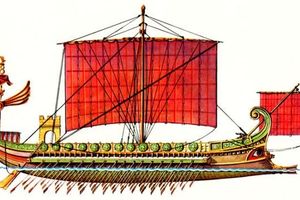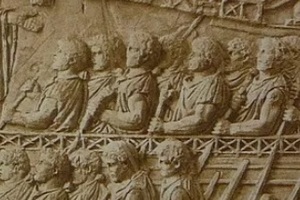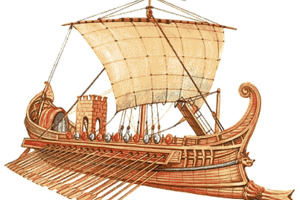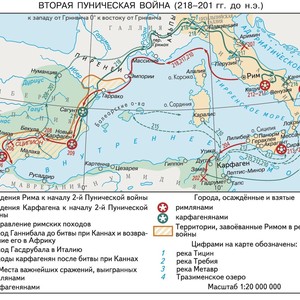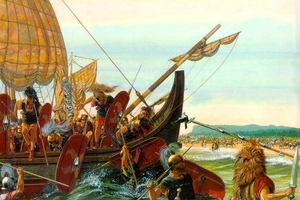History of the Republican Fleet of ancient Rome
The First Punic War: The Birth of the Military Fleet
The Roman Republic, which emerged after the expulsion of King Tarquinius Superbus, waged numerous wars with its neighbors in its early stages, conquering all Italian tribes over the course of approximately two centuries. In many of these wars, Carthage was an ally of the young Roman Republic. However, after the defeat of King Pyrrhus, the paths of the allies diverged. The Roman Republic attempted to establish itself in Sicily, a prosperous island that was under Carthaginian influence, leading to the outbreak of the First Punic War (264-241 BCE).
Unlike previous wars fought by the Republic, the key to victory in the war against the Carthaginians lay in naval actions. The fleet played a crucial role in supplying the army on the islands and protecting the coastlines from potential enemy landings. However, the Republican fleet was in its infancy and weak, suffering defeats in open battles against the Carthaginians.
In 260 BCE, fortune smiled upon the Romans when they captured a Carthaginian quinquereme and used it as a model. This turned the tide of the war at sea. The first victory of the Roman fleet occurred in the Battle of Mylae in the same year. Hannibal Gisco, the Carthaginian naval commander, set sail with his fleet of 130 ships on a raid along the Italian coast. He was met by a fleet of approximately 120 ships commanded by Gaius Duilius, who sailed out from Messana. The ships of his fleet were equipped with "ravens" (Latin: corvus) - boarding bridges. During the battle, about 30 enemy ships were captured, including the flagship quinquereme, and 14 ships were sunk. The Roman fleet lost only 11 ships. It was the Romans' use of naval infantry and boarding tactics, combined with the negligence of the Carthaginian naval commander, that allowed the Romans to turn the tide of the war at sea. Gaius Duilius became the first victorious fleet commander in the history of the Republic, and he was honored with a triumph.
In 256 BCE, the Senate sanctioned the landing of an army in North Africa. The amphibious operation involved four legions that were to be transported by four squadrons of the fleet. During the transfer of the landing force, the Roman fleet of consuls Marcus Atilius Regulus and Lucius Manlius Vulso Longus was attacked by superior Carthaginian forces under the command of naval commander Hamilcar Barca. In a tense battle, the Carthaginian fleet, losing 30 ships destroyed and 64 ships taken as captives, was defeated and retreated. The landing in North Africa was successful.
As a result of the war, the fleet of the Roman Republic transformed into a formidable force that could challenge Carthaginian dominance at sea. The role of the fleet in that war was immense, as it was necessary to transport and supply massive land armies. Additionally, the fleet's forces were engaged in defending the Italian coastline from Carthaginian naval raids.
Illyrian Wars
In 229-228 BCE and 219-218 BCE, the Roman Republic waged wars against the Illyrian tribes. The cause of these wars was the Illyrian pirates who plundered Roman trade vessels, disrupting the increased maritime trade of Rome in the region. The naval power of the Roman Republic had grown after the First Punic War, prompting the Senate to declare war against the Illyrians. Large naval forces, consisting of approximately 200 warships, appeared in the eastern waters of the Adriatic Sea. A landing was made by the fleet near the major Greek port city of Apollonia. The outcome of the campaigns was the gradual incorporation of Illyrian lands into the Republic and the eradication of piracy in the Adriatic Sea.
Second Punic War: The Beginning of Roman Maritime Supremacy
In 218 BCE, the Second Punic War (218-201 BCE) began. The main actions of this war took place on land, but the Roman fleet played a significant role in the military operations. After the First Punic War, Roman maritime supremacy was unquestionable, and the Roman fleet outnumbered the Carthaginian fleet. The Roman fleet was tasked with defending the Italian coast and territorial waters of the Republic, as well as conducting amphibious operations in North Africa and Spain. For example, Titus Livius mentions the praetor Titus Otacilius Crassus, who commanded a patrol squadron and was responsible for the defense of the Italian coast. The constant patrol of maritime borders and the presence of a strong Roman fleet, according to historian A.A. Khlevov, forced Carthaginian general Hannibal to transport his army to Italy by land, while maritime transportation would have been much faster.
In 214 BCE, the Macedonian king Philip V initiated a war against Rome on the side of Carthage. He attacked Roman possessions in Illyria but faced strong resistance from the Roman Republic's naval forces, which resulted in his fleet being blockaded in his own harbor.
In 210 BCE, Publius Scipio conducted a landing operation near the city of Tarraco, Spain. The operation involved at least 60 warships and an entire legion. This victory marked his debut as a military commander and once again affirmed the special importance of the naval fleet in military operations. Scipio's army successfully advanced through Tarraco and Sagunt, besieged the fortress of Nova Carthago (Cartagena), and reached Gades, a city in southern Spain.
Scipio's campaign and the capture of the Spanish coast allowed for the process of incorporating the entire Iberian Peninsula into the Roman Republic. The fleet played a crucial role in ensuring the supply lines for the active army. Similar amphibious operations would have been impossible without Rome's total dominance in the Mediterranean Sea, which helped maintain uninterrupted supply to the army on the front lines in Spain.
Six years later, in 204 BCE, an even larger-scale landing operation was carried out by the fleet. An army under the command of Publius Scipio was landed on the land of North Africa near the city of Utica, not far from Carthage. In the Battle of Zama in 202 BCE, Scipio commanded an infantry force of 20,000 soldiers who were transported by sea. The victory of the Romans at the Battle of Zama marked the end of the Second Punic War. The Roman fleet played a significant role in this victory as it was responsible for supplying the African army. Just as "the theater starts with the wardrobe," the victory of the army in battle begins with well-organized logistical support.
The final confrontation with Carthage at sea would end in the spring of 146 BCE when the Roman soldiers finally destroyed Carthage. During the Third Punic War (148-146 BCE), a Roman army of 80,000 troops crossed to Africa and landed in Utica. The army and fleet were under the command of the fleet prefect Lucius Marcius Censorinus. The main contribution of the fleet to the successful siege of Carthage was the transportation of a significant number of soldiers by sea, which was necessary for the siege.
Syrian War (192-188 BCE)
The Syrian War, also known as the war against the Seleucid Kingdom, began after the Syrian king Antiochus III the Great sought to expand his sphere of influence. His forces captured some Greek cities, and Antiochus also aimed to seize the Palestinian territories of the Ptolemaic dynasty, long-standing allies of the Republic. These conflicts, along with the existence of an "anti-Roman party" within the Syrian kingdom, ultimately led to war.
The war initially went well for Antiochus. However, in 191 BCE, his land army was defeated at Thermopylae, and the Syrian fleet was sunk between Ionia and Chios. In 190 BCE, the Roman fleet dealt another blow to the Syrians. In the mouth of the Eurymedon River (modern-day Turkey, near Antalya), Lucius Aemilius Regillus defeated one of the squadrons of the Syrian fleet. Another Syrian squadron, which remained combat-ready, was defeated in the Maliacus Gulf near the island of Mionnes, Greece. The ships sent from the island of Rhodes, whose inhabitants were allies of Rome, played a significant role in the naval battles against the Syrians. After gaining naval supremacy, the Romans landed their army on the Anatolian Peninsula. Soon after, the Battle of Magnesia took place, concluding the war with a Roman victory.
Once again, the fleet demonstrated its importance. By defeating the Syrians at sea and conducting a landing on enemy territory, the fleet played a crucial role. As a result of the battle, Antiochus was forced to end the war by liberating the Greek territories.
The Landing of Caesar in Britain
Significantly later than the events described above, in 55 and 54 BCE, Gaius Julius Caesar made attempts to land in Britain and conquer it. These events were documented by Caesar in his "Commentaries on the Gallic War," Book IV. Landing in Britain posed a very complex logistical challenge for Caesar. It required the rapid transportation of legions across the channel. For the purpose of coastal reconnaissance to determine the future landing site, Gaius Volusenus was sent on a ship. After five days at sea, he returned with information.
The troops set off on August 23. For the initial landing, Caesar utilized about 100 ships scattered in different ports. Due to poor weather conditions and inadequate fleet coordination, the landing in 55 BCE ended in failure. According to Caesar's account, the ships arrived at their destination at different times. For example, the cavalry arrived significantly late. Moreover, the situation was worsened by bad weather, a raging storm, and strong tides that severely damaged many ships in the fleet. As a result, the land army, which had not carried sufficient equipment and provisions, was forced to evacuate the island. The fleet suffered from the natural elements and was unable to provide regular supplies to the army. It's worth mentioning that the landing of the troops was conducted with resistance on an unprepared beach. During the landing, the Roman ships could not approach the shore closely, so the soldiers had to jump into the water.
During the second landing in 54 BCE, Caesar endeavored to learn from past mistakes. According to Caesar, approximately 800 ships with armed escorts participated in the landing. The ship design was borrowed from the Veneti, a seafaring people living on the northern coast of modern-day France. Additionally, the number of infantry and cavalry was increased (five legions and 2,000 horsemen). Choosing suitable weather conditions, Caesar's army commenced the landing.
Caesar's second landing was more successful than the first. His forces achieved victories in several battles against local armies and tribal alliances. The legions began advancing deeper into British territory. The fleet played a vital role in the success of the second expedition as it maintained communication with the mainland. However, there were still incidents during this expedition. Due to strong tides and storms, several dozen ships suffered significant damage. However, replacements were sent from the mainland to replace the damaged vessels.
In the end, despite the Roman troops returning to the mainland after the second expedition, some British tribes became allies of Rome or started paying tribute. Undoubtedly, the military transport fleet played a crucial role in the success of this campaign. This becomes particularly evident when comparing the expeditions of 55 and 54 BCE. The failure of the first expedition was directly related to the condition of the fleet. It was the fleet that provided supplies to the army on the island. When the fleet was successfully maintained during the second expedition, the land military operations concluded successfully. As for Britain, it would be conquered during the Imperial period under Emperor Claudius.
